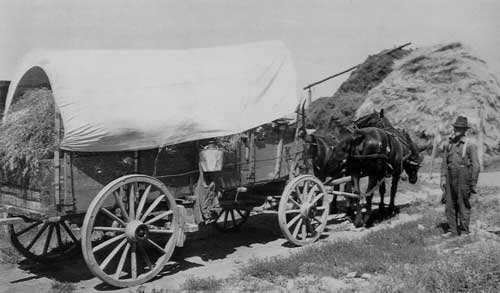The last covered wagon immigration to South Hill
by Carl Vest
 Ole Gabrielson covered wagon
Ole Gabrielson covered wagon
Many local pioneer families have stories to tell about how their relations came to South Hill. Some state their ancestors crossed the country in covered wagons during the 1840s and 1850s. Commonly they used the route through Oregon City and then came north along the west side of the mountains. Others say their relatives came by a more direct path. Probably the best known group doing this was the Longmire-Byles wagon train that crossed the Cascade Mountains in late 1853, coming through the Naches Pass. Thus, it must be accepted that coming into the Puget Sound area by covered wagon was not uncommon during the early settlement period. But when did the use of covered wagons stop? When did the last party arrive, the 1860s, 1870s, or when? We do know that since the last quarter of the 19th century a number of covered wagon re-crossings and reenactments have been done along the various trails. But such activities don’t count as immigrant parties.
Actually, we don’t know who or when the last family came to South Hill by covered wagon. But the South Hill Historical Society has uncovered a record that just may answer that question. We now know that on August 12, 1921, the Ole Gabrielson family left Pocatello, Idaho, in a covered wagon, bound for South Hill. They would settle near the intersection of present day 152nd Street and 86th Avenue. They traveled the entire way by covered wagon. The family consisted of Ole, his wife Emily, and a six week old daughter, Margie. Unlike earlier immigrants who used oxen, this wagon was pulled by two horses named Jake and Fly. Fly, a female, had a three month old colt with her. For the most part the party first traveled on the old Oregon Trail and subsequently on the Naches Pass Trail. They did not go through Naches Pass, however, but instead crossed the mountain through Snoqualmie Pass.
The family first went to Arlington, WA, and rested with a relative. They then continued the trip to South Hill. Diary records show that it took 43 days to travel between Pocatello and Arlington. While records do not exist it is estimated it took another five days to reach South Hill. So the entire trip took about 50 days. It was about 850 miles or roughly 17 miles per day.
While the horses were able to make the entire trip the colt did not. It was sold for $5.00 on August 19th near Picaboo, Idaho. It should also be pointed out that this wagon was not the only one on the trail at that time. A diary entry, for example, for August 29th notes that another wagon was camping at the same place as they were and that it had a broken wheel.
The family apparently made the trip in fine shape. Mrs. Gabrielson is quoted as saying, “Baby was 3 months old when we arrived … not a cold or anything else wrong, not even a diaper-rash.”
Carl Vest, PhD, is a founding member and Research Director for the South Hill Historical Society.